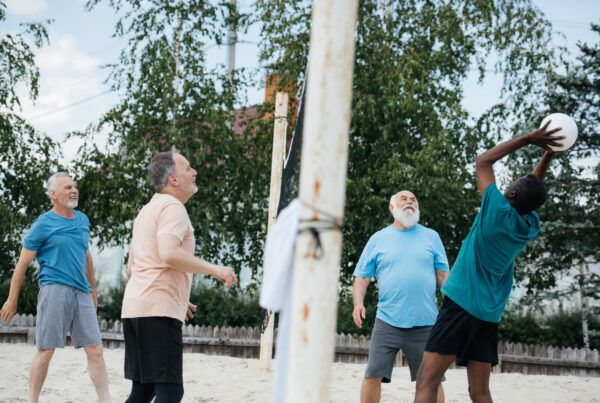”Question: How do I remain consistent with my new exercise routine?
Reading time: 5 Minutes
MWi Hack:
- Learn how to change the common all or nothing mindset around exercise to have a better relationship with movement, and create consistency around exercise in 2024.
MWi Summary:
- Your workouts do not have to be long or exhaustive to be effective.
- You can think about minimum effective dose (MED) to help you live a healthy life. For most people, this means moderate exercise 3-4 times a week.
- MED changes based on your goals. For example, balancing effort and volume is key if your goal is strength-based.
- If you have fitness based goals, think about applying MED holistically across endurance, strength, and mobility goals.
With everything and everyone saying you’re not doing enough, it’s easy to believe that the only way to be fit is to train as if you were aiming for a spot at the next Olympics.
But it isn’t so. You don’t have to work out all day every day to see results.
Some athletes might require high levels of purposeful training. An Olympic swimmer hoping to shave a tenth of a second off her 50-meter freestyle, for example, might need three hours of exercise a day.
But for most people who want to build strength for a healthy everyday life, three workouts of 30 to 60 minutes each week is often sufficient. And a sedentary person might get measurable improvements in fitness from even a brisk walk every day.
“It all depends on your goals and your training status,” says Life Time national education manager Jason Stella, NASM, PES, CES.
The misguided belief that you need to go hard or go home prevents many people from sticking with a fitness routine — or sometimes from even getting started. They may think it’s not doable, not worth it, or not tenable.
Rather than wondering how much exercise you can cram into your already busy life, a better question might be “What is the minimum effective dose of exercise for my goals?”
In fact, a minimum effective dose (MED) of exercise can get most people most of the way to their fitness goals. Another way to think about this is that most of the results come from a small portion of work.
So, rather than wondering how much exercise you can cram into your already busy life, a better question might be “What is the minimum effective dose of exercise for my goals?”
The answer, it seems, is pretty darn minimal.
The Minimum Effective Dose
If you’re seeking increased longevity and protection from chronic disease, the Centers for Disease Control and Prevention recommends 150 minutes of moderate exercise a week, or 30 minutes most days of the week. “Moderate exercise” is about a 5 or 6 on an effort scale of 1 to 10 — a brisk walk is just about right.
That regimen is not only humane but flexible. “When you’re going minimal, it doesn’t matter whether you do your movement all at once or in little snacks,” says trainer Ebenezer Samuel, CSCS.
Three 10-minute walks a day is as good as one 30-minute walk. And if five 30-minute walks over the course of a week isn’t feasible, three 50-minute walks will do. Just get that movement in.
Many people, though, aren’t only seeking to maintain their status quo or stave off chronic disease; they’re seeking more strength, more endurance, and more mobility. For them, the MED is higher — but in most cases, it’s still surprisingly low. Here’s how it breaks down for these common fitness goals.
Increasing Strength
If your goals revolve around building strength and muscle, “85 percent of your maximum gains could be seen with just three 60-minute sessions per week — three hours total,” says Bret Contreras, PhD, author of Glute Lab.
The key to progress is how you spend that time — specifically, the balance of effort and volume.
While both are important, Contreras says, effort (how hard you work relative to your maximum capacity) matters more than volume (the total amount of physical work you perform, usually calculated by multiplying reps by weight lifted).
You can gauge your effort based on the rate of perceived exertion (RPE): a scale of 1 to 10 where 1 is as easy as sitting on the couch and 10 is your absolute max capacity.
That doesn’t mean you have to use maximal weight and push to failure. Rather, after warm-ups, each set will get close to your maximum effort — an 8 or higher on your RPE scale.
“When you’re working minimally, intensity matters more than volume or frequency,” agrees Samuel.
Aim for one or two sets of one or two moves per muscle group, three times a week. Just make sure you push those sets to the edge.
Amping Up endurance
Your options for aerobic exercise comprise more than just long endurance sessions. As with strength building, you can improve your cardiovascular functioning with a minimal time commitment.
In addition to tracking your step count, another time-saving cardio fix is performing a couple sessions per week of high-intensity interval training (HIIT).
In each HIIT workout, you perform repeated, short bursts of near-maximal effort, each followed by a rest period. The duration of your work and rest periods can vary — some coaches recommend work periods of up to 60 seconds, with rest periods about twice that long. But a 2021 study suggests that you can get measurable benefits from even four-second bouts of high-effort activity, each followed by 15 to 30 seconds of rest, repeated for 10 to 20 minutes.
Do these workouts twice a week — ideally on a low-impact cardio machine, like an air bike, a rowing machine, or a stairclimber — and you’ll give your heart health and stamina a boost.
For this strategy to succeed, though, the intervals in a HIIT workout must be high effort — likely higher than you’re used to. You need to make up for what you lose in volume with additional levels of effort.
Improving Mobility
To maintain or improve range of motion or to warm up for a workout, most trainers agree, static stretching — holding a toe-touch position for 30 seconds or more, for example — is less effective than dynamic stretching. With dynamic stretches, you repeatedly move in and out of a stretched position, as in a high-knee walk or a standing arm-circle movement.
To improve joint range of motion, “stretch the muscles you plan to work for one to three minutes before your strength workouts,” advises physical therapist and strength coach John Rusin, DPT, CSCS.
Once your workout begins, be sure to use a full, controlled range of motion on all your strength moves: stretching your arms fully when you do a row or a pull-down; squatting as low as possible (provided you don’t experience pain); or lowering your chest as far as possible on pushups.
This strategy — strengthening a muscle after you’ve lengthened it — leads to adaptations that are not stimulated by stretching alone, Rusin explains. “Your body has to stabilize the new range of motion, which leads to more lasting improvements in flexibility.”






